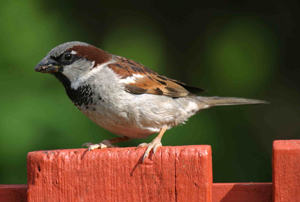House Sparrow Questionnaire
The first component of the BTO House Sparrow Survey was a questionnaire, designed to collect information on House Sparrows in gardens and, in particular, to highlight possible factors in House Sparrow decline. The questionnaire was sent out in 2002 to all BTO Garden BirdWatchers and to any other people interested in contributing their observations to the survey.
Preliminary results from the 11,269 useable returns were published as an insert to Bird Table 36.
What we discovered:
The House Sparrow Questionnaire was divided into sections covering the various factors implicated in the decline of House Sparrows within urban and suburban habitats. Analyses carried out on the responses to questions within each of these sections revealed some interesting patterns.
Section One: Buildings
House Sparrows were more likely to occur at sites where there were gaps in the roof tiles. Modern tile designs do not have these gaps and House Sparrow nest sites may be lost where re-roofing takes place. Just over 25% of respondents reported that they had had such gaps blocked, many within the last ten years, and 7% within the last year. The addition of loft insulation (90% of lofts were known to be insulated) may also influence House Sparrows.
Section Two: Gardens
Features within individual gardens were found to have little effect on whether or not House Sparrows were present in a garden, suggesting perhaps that it is the wider environment that will ultimately determine the presence or absence of House Sparrows. However, House Sparrows were more likely to be reported from suburban and urban gardens than rural ones, something that matches our understanding derived from other BTO surveys. Not surprisingly, House Sparrows were more likely to occur at those sites where food was provided year-round than at those where feeding only took place occasionally or not at all.
Section Three: The wider landscape
Some 16 variables describing the landscape outside a garden (such as the presence of allotments, arable land, schools, parks and wasteground) were significantly associated with the presence of House Sparrows in gardens. In broad terms, these associations suggest that House Sparrows occur with higher frequency where sites are close to farmland or where they are close to suburban features such as schools, parks or wasteground.
Section Four: Predators, competitors and mortality
There were a number of significant associations with other species, most of which were related to the habitat preferences of House Sparrows and the other species with which they were associated. It is interesting to note that House Sparrows were more likely to occur at those sites where Sparrowhawks were present, possibly suggesting that predation by these avian predators may not be important (c.f. Chamberlain et al. 2009).
Dead or dying House Sparrows were recorded at 6% of sites where this part of the questionnaire had been completed. The likelihood of finding a dead sparrow was similar across rural, suburban and urban gardens but there was an interesting association between dead sparrows and the volume of traffic recorded outside the house, with dead sparrows more likely to be found at sites near busier roads.
The results from this questionnaire were useful in guiding the work that we went on to carry out through an extensive field study, carried out in 1,500 survey squares. Find out more about the results of this fieldwork.







Share this page